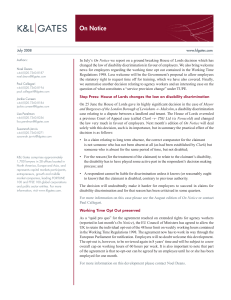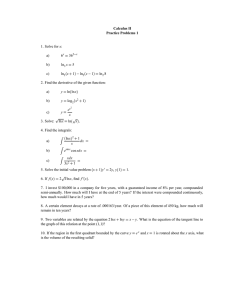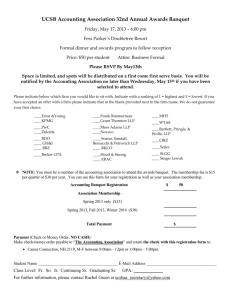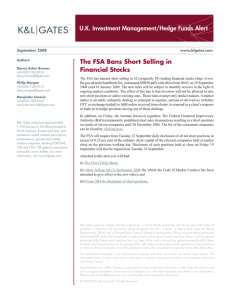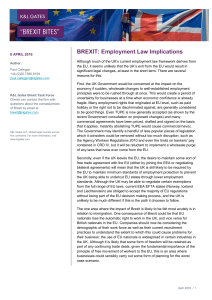On Notice
advertisement
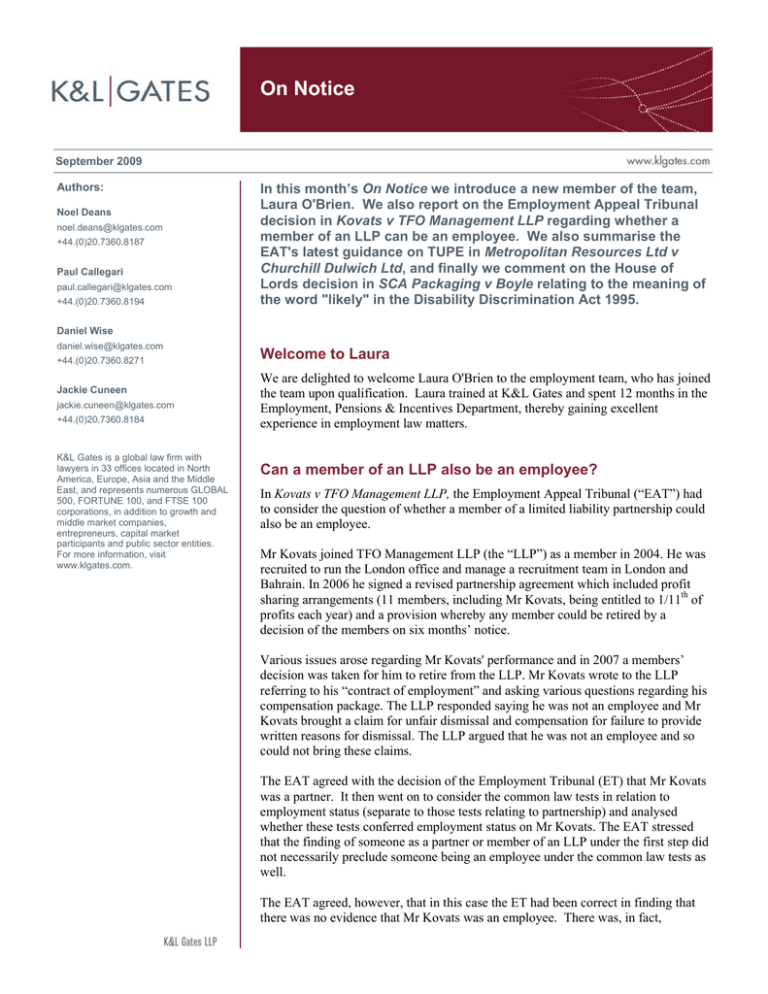
On Notice September 2009 Authors: Noel Deans noel.deans@klgates.com +44.(0)20.7360.8187 Paul Callegari paul.callegari@klgates.com +44.(0)20.7360.8194 In this month’s On Notice we introduce a new member of the team, Laura O'Brien. We also report on the Employment Appeal Tribunal decision in Kovats v TFO Management LLP regarding whether a member of an LLP can be an employee. We also summarise the EAT's latest guidance on TUPE in Metropolitan Resources Ltd v Churchill Dulwich Ltd, and finally we comment on the House of Lords decision in SCA Packaging v Boyle relating to the meaning of the word "likely" in the Disability Discrimination Act 1995. Daniel Wise daniel.wise@klgates.com +44.(0)20.7360.8271 Jackie Cuneen jackie.cuneen@klgates.com +44.(0)20.7360.8184 K&L Gates is a global law firm with lawyers in 33 offices located in North America, Europe, Asia and the Middle East, and represents numerous GLOBAL 500, FORTUNE 100, and FTSE 100 corporations, in addition to growth and middle market companies, entrepreneurs, capital market participants and public sector entities. For more information, visit www.klgates.com. Welcome to Laura We are delighted to welcome Laura O'Brien to the employment team, who has joined the team upon qualification. Laura trained at K&L Gates and spent 12 months in the Employment, Pensions & Incentives Department, thereby gaining excellent experience in employment law matters. Can a member of an LLP also be an employee? In Kovats v TFO Management LLP, the Employment Appeal Tribunal (“EAT”) had to consider the question of whether a member of a limited liability partnership could also be an employee. Mr Kovats joined TFO Management LLP (the “LLP”) as a member in 2004. He was recruited to run the London office and manage a recruitment team in London and Bahrain. In 2006 he signed a revised partnership agreement which included profit sharing arrangements (11 members, including Mr Kovats, being entitled to 1/11th of profits each year) and a provision whereby any member could be retired by a decision of the members on six months’ notice. Various issues arose regarding Mr Kovats' performance and in 2007 a members’ decision was taken for him to retire from the LLP. Mr Kovats wrote to the LLP referring to his “contract of employment” and asking various questions regarding his compensation package. The LLP responded saying he was not an employee and Mr Kovats brought a claim for unfair dismissal and compensation for failure to provide written reasons for dismissal. The LLP argued that he was not an employee and so could not bring these claims. The EAT agreed with the decision of the Employment Tribunal (ET) that Mr Kovats was a partner. It then went on to consider the common law tests in relation to employment status (separate to those tests relating to partnership) and analysed whether these tests conferred employment status on Mr Kovats. The EAT stressed that the finding of someone as a partner or member of an LLP under the first step did not necessarily preclude someone being an employee under the common law tests as well. The EAT agreed, however, that in this case the ET had been correct in finding that there was no evidence that Mr Kovats was an employee. There was, in fact, On Notice evidence to the contrary: Mr Kovats had signed agreements that were wholly compatible with his being a partner, he had considerable autonomy in his role, he never suggested he was an employee until he was voted out of the LLP, he received no remuneration and instead expected to share in the profits of the LLP and his share of the profits was paid gross and he accounted for income tax himself. The question of whether an individual is an employee is extremely important as numerous rights, duties and liabilities (including, as in this case, the right to claim unfair dismissal) are available only to employees. This case is a strong reminder that tribunals will look at the substance of a relationship between parties rather than the label attached by the parties themselves. Although in this case the result was favourable for the LLP, if the factual matrix had been different a relationship of employer/employee could have been found notwithstanding the fact that Mr Kovats was a member and partner of the LLP. It should also be remembered that the EAT will interfere in Tribunal decisions of this kind only if they are manifestly unfair and a considerable degree of latitude is, therefore, given to Tribunals in the first instance to apply the test to the relevant factual matrix. Notwithstanding its decision in this matter, it continues to be difficult to accurately predict a Tribunal's finding in cases of this sort. Care should therefore be taken to factor in this level of uncertainty when addressing business decisions in this area. For further information on this case please contact Noel Deans. Service provision change under TUPE In Metropolitan Resources Ltd v (1)Churchill Dulwich Ltd, (2) Martin Cambridge & Others, the EAT gave guidance on how to determine when there has been a service provision change for the purpose of the Transfer of Undertakings (Protection of Employment) Regulations 2006 (“TUPE”). The case concerned the Migrant Helpline which had contracted with Churchill Dulwich Ltd ("CD") to provide accommodation for asylum seekers. From 26 January 2007, the Migrant Helpline started sending all new asylum seekers to different accommodation owned by Metropolitan Resources Ltd ("MR"). The ten Claimant employees of CD remained at the previous accommodation until the contract between the Migrant Helpline and CD expired. CD subsequently wrote to MR stating that they believed the ten Claimant employees transferred to MR under a TUPE service provision change. MR disagreed and CD and the ten Claimant employees brought a claim in the ET. TUPE provides, under Regulation 3(1) and (3) that a service provision change occurs when: 1. Activities cease to be carried out by a person (“a client”) on his own behalf and are carried out instead by another person on the client's behalf (“a contractor”); or 2. Activities cease to be carried out by a contractor on a client's behalf (whether or not those activities had previously been carried out by the client on his own behalf) and are carried out instead by another person (“a subsequent contractor”) on the client's behalf; or 3. Activities cease to be carried out by a contractor or a subsequent contractor on a client's behalf (whether or not those activities had previously been carried out by the client on his own behalf) and are carried out instead by the client on his own behalf. Immediately before the service provision change there must be: 1. An organised grouping of employees situated in Great Britain which has as its principal purpose the carrying out of the activities concerned on behalf of the client; and 2. The client intends that the activities will, following the service provision change, be carried out by the transferee. At a pre-hearing review, the ET focused on the question of whether there had been a change of service provider for the purposes of TUPE. MR argued that there had not been a service provision change. It said that there were a different number of beds provided, that the location of the beds was different and that the asylum seeker's stay was longer under its service. This meant that it was providing a different service than that of its predecessor and so TUPE did not apply. September 2009 2 On Notice The ET disagreed and decided that MR was carrying out essentially the same services as CD. The ET decided that the location at which the activity took place was not integral to the definition of "activity", nor were the facts that there were more beds or that an overnight service was provided by MR. The ET also found that CD had also ceased to carry out services for the Migrant Helpline. The ET, therefore, found that the provisions of TUPE set out above were satisfied and there was a service provision change. In addition, the ET decided that the transfer date was on 26 January 2007, when all new asylum seekers were sent to the new accommodation provided by MR. The EAT dismissed an appeal from MR and upheld the ET’s decision. It decided that the minor discrepancies in the service provided by MR compared with that previously provided by CD did not preclude the ET from finding that there was a service provision change. This case is interesting because although there were minor differences between the service provided by CD and MR, this did not preclude the application of TUPE. There is still some uncertainty, however, about how far the service must differ before TUPE ceases to apply - at what point can it no longer be said that the "activity" is the same before and after? Given this is a relatively new piece of legislation it is likely that a body of case law will build up over time to deal with issues of that sort. Until then, it is advisable in the context of a reorganisation of this sort to adopt caution when applying the new TUPE rules. For further information on this case please contact Paul Callegari The ET had decided that the employee did suffer from an impairment in the form of hoarseness and vocal nodes. Further, it found that when she was suffering from vocal nodes this did have an adverse impact on her day to day routines. The management regime that the employee followed to minimise the effect of her impairment went far beyond the coping strategies envisioned by the guidance the ET considered. On the balance of probability the ET decided the vocal nodules were “likely” to recur for the purpose of the definition of disability in the DDA and accordingly the employee was disabled. When the matter was referred to the Court of Appeal it discussed the meaning of the phrase “likely to have a substantial adverse effect” in paragraph 6(1) of the DDA and concluded that the meaning of “likely” in that context meant “could well happen” as opposed to on the balance of probabilities. This marked a departure from previous case law on the matter where likely was interpreted as being something that had over a 50% chance of happening (“on the balance of probabilities”), a much higher threshold. The House of Lords adopted the Court of Appeal’s reasoning and found that in the context of the DDA “likely” meant “could well happen”. “Could well happen” is a lower test than on the balance of probabilities. The upshot of this decision is that it will be easier for individuals in a wider range of situations to establish they are entitled to the DDA’s protection. Employers should note that where an employee raises a heath related concern this should be taken seriously and the DDA’s requirements considered. To this end, it is rarely inappropriate, when costs permit, for companies to obtain medical reports on issues of this kind at an early stage to allow their subsequent treatment of such employees to be informed. House of Lords considers DDA SCA Packaging v Boyle is a House of Lords decision on the issue of what comprises a disability under the Disability Discrimination Act 1995 (the “DDA”). In this case, the Claimant suffered from hoarseness and nodules on her vocal cords. Her disability was managed on a day to day basis by speech therapy and a management regime including avoiding straining her voice. Employers should also note that the lowering of the test means that the courts will be less disposed to deal with pre-hearing issues of whether there was a disability and will want to focus on arguments surrounding reasonable adjustments instead. Any litigation strategy should take this new approach into account. For further information on this case please contact Dan Wise. September 2009 3 On Notice Anchorage Austin Beijing Berlin Boston Charlotte Chicago Dallas Dubai Fort Worth Frankfurt Harrisburg Hong Kong London Los Angeles Miami Newark New York Orange County Palo Alto Paris Pittsburgh Portland Raleigh Research Triangle Park San Diego San Francisco Seattle Shanghai Singapore Spokane/Coeur d’Alene Taipei Washington, D.C. K&L Gates is a global law firm with lawyers in 33 offices located in North America, Europe, Asia and the Middle East, and represents numerous GLOBAL 500, FORTUNE 100, and FTSE 100 corporations, in addition to growth and middle market companies, entrepreneurs, capital market participants and public sector entities. For more information, visit www.klgates.com. K&L Gates comprises multiple affiliated partnerships: a limited liability partnership with the full name K&L Gates LLP qualified in Delaware and maintaining offices throughout the United States, in Berlin and Frankfurt, Germany, in Beijing (K&L Gates LLP Beijing Representative Office), in Dubai, U.A.E., in Shanghai (K&L Gates LLP Shanghai Representative Office), and in Singapore; a limited liability partnership (also named K&L Gates LLP) incorporated in England and maintaining offices in London and Paris; a Taiwan general partnership (K&L Gates) maintaining an office in Taipei; and a Hong Kong general partnership (K&L Gates, Solicitors) maintaining an office in Hong Kong. K&L Gates maintains appropriate registrations in the jurisdictions in which its offices are located. A list of the partners in each entity is available for inspection at any K&L Gates office. This publication is for informational purposes and does not contain or convey legal advice. The information herein should not be used or relied upon in regard to any particular facts or circumstances without first consulting a lawyer. ©2009 K&L Gates LLP. All Rights Reserved. September 2009 4

